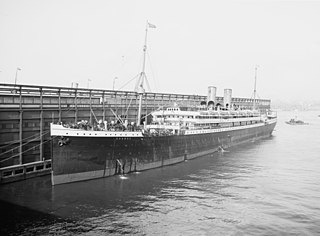
Kaiser Wilhelm der Grosse was a German transatlantic ocean liner in service from 1897 to 1914, when she was scuttled in battle. She was the largest ship in the world for a time, and held the Blue Riband until Cunard Line’s RMS Lusitania entered service in 1907. The vessel’s career was relatively uneventful, despite a refit in 1913.

An ocean liner is a type of passenger ship primarily used for transportation across seas or oceans. Ocean liners may also carry cargo or mail, and may sometimes be used for other purposes. The Queen Mary 2 is the only ocean liner still in service to this day.
Norddeutscher Lloyd was a German shipping company. It was founded by Hermann Henrich Meier and Eduard Crüsemann in Bremen on 20 February 1857. It developed into one of the most important German shipping companies of the late 19th and early 20th centuries, and was instrumental in the economic development of Bremen and Bremerhaven. On 1 September 1970, the company merged with Hamburg America Line (HAPAG) to form Hapag-Lloyd AG.

USS Zeppelin was a passenger liner launched in 1914 as SS Zeppelin by Bremer Vulkan, Bremen-Vegesack, Germany, for Norddeutscher Lloyd (NDL). Due to the First World War she never entered NDL service. She had a career after the war first under White Star Line control, then briefly as the troop ship USS Zeppelin, next as the Orient SN Co liner SS Ormuz and finally back with NDL as SS Dresden.

The SS Bremen, later renamed Constantinople and then King Alexander, was a German Barbarossa class ocean liner commissioned in 1897 by Norddeutscher Lloyd.
Bremen is a city in northwestern Germany.

SS Scharnhorst was a Norddeutscher Lloyd ocean liner, launched in 1934, completed in 1935 and made her maiden voyage on 8 May 1935. She was the first big passenger liner built by the Third Reich. Under the German merchant flag, she was the second liner named after General Gerhard J. D. von Scharnhorst. She was one of three ships on the Far Eastern route between Bremen and Yokohama; her sister ships were Potsdam and Gneisenau. These three ships were planned to shorten the journey time between Bremen and Shanghai from the usual 50 days to 34. She was trapped in Japan in September 1939 and later converted into an Imperial Japanese Navy aircraft carrier named Shin'yō in 1942 and sunk by the US submarine USS Spadefish in 1944.

SS Scharnhorst was a German ocean liner and mail ship launched in 1904.
RMS or SS Empress of China may refer to one of these Canadian Pacific Steamship Company ocean liners:
SS Taormina may refer to the following ships:
SS München was the name of a number of ships.
Adler was the name of four ships of Argo Line, Germany

The first RMS Saxonia was a passenger ship of the British Cunard Line. Between 1900 and 1925, Saxonia operated on North Atlantic and Mediterranean passenger routes, and she saw military service during World War I (1914–1918).

The Kaiser-class ocean liners or Kaiserklasse refer to four transatlantic ocean liners of the Norddeutscher Lloyd, a German shipping company. Built by the AG Vulcan Stettin between 1897 and 1907, these ships were designed to be among the largest and best appointed liners of their day. These four ships, two of which held the prestigious Blue Riband, were known as the "four flyers" and all proved to be popular with wealthy transatlantic travellers. They also took great advantage of the masses of emigrants who wished to leave Europe.
SS Eider was a 4,179 ton German ocean liner built for Norddeutscher Lloyd in 1884 by John Elder & Co. of Glasgow as the fourth ship in the Rivers class. She had four masts and was a two-funnelled steamer 430 feet (130 m) long, with a crew of 167, and capable of carrying 1,204 passengers. However, she had a short service history, being lost in what is remembered as one of the most impressive and memorable shipwrecks on the coast of the Back of the Wight, a region on the Isle of Wight, England.

The Rivers class was a class of eleven ocean liners of the Norddeutscher Lloyd (NDL), the first class of German express liners. The ships were built between 1881 and 1890, the first nine in Glasgow by John Elder & Co. or the renamed Fairfield Shipbuilding and Engineering Company, the last two in Stettin by Vulcan. All were named for rivers in Germany.
SS Berlin may refer to one of the following ships
Several steamships have borne the name Main:

SS Burdigala was an ocean liner that sailed the Atlantic Ocean from 1898 until World War I. The ship was built as the Kaiser Friedrich in 1898 for Norddeutscher Lloyd (NDL), a German shipping line. Designed to break the speed record for a transatlantic liner and thereby win the Blue Riband, the Kaiser Friedrich never achieved the necessary speeds. After a short career with NDL and an equally short period of service with NDL's main German competitor, the Hamburg-Amerikanische Packetfahrt-Aktien-Gesellschaft, the ship was mothballed for a decade. After being sold to the French shipping line Compagnie de Navigation Sud-Atlantique, it re-entered service as SS Burdigala. In 1916, while en route from Thessaloniki to Toulon, the liner struck a mine laid by the German U-boat U-73 in the Aegean Sea and sank near Kea, Greece.
This page is based on this
Wikipedia article Text is available under the
CC BY-SA 4.0 license; additional terms may apply.
Images, videos and audio are available under their respective licenses.









